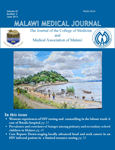
|
Malawi Medical Journal
College of Medicine, University of Malawi and Medical Association of Malawi
ISSN: 1995-7262
Vol. 32, No. 1, 2020, pp. 24-30
|
 Bioline Code: mm20005
Bioline Code: mm20005
Full paper language: English
Document type: Research Article
Document available free of charge
|
|
|
Malawi Medical Journal, Vol. 32, No. 1, 2020, pp. 24-30
| en |
Characteristics of interpersonal violence in adult victims at the Adult Emergency Trauma Centre (AETC) of Queen Elizabeth Central Hospital
Sheikh, Shabnam; Chokotho, Linda; Mulwafu, Wakisa; Nyirenda, Mulinda; Le, Grace; Mbomuwa, Foster; Pandit, Hemant & Lavy, Chris
Abstract
Introduction
Globally, the burden of interpersonal violence and its significant impact on mortality, morbidity and disability makes it a major public
health problem which necessitates intervention. This article examines characteristics of victims of interpersonal violence and violent
events in Malawi. The focus is on a population that has been traditionally neglected in literature.
Methods
Queen Elizabeth Central Hospital (QECH) maintains a trauma registry with data that is prospectively collected. Patients offered
trauma care after interpersonal violence from May 2013 to May 2015 were evaluated.
Results
There were 1431 patients with violent events recorded at the Adult Emergency Trauma Centre (AETC) with a male predominance of
79.5%. The dominant age group was young adults between 25-29 years old (22%). Most attacks occurred during cold and dry season
(46.9%) and most common location was on the road (37.2%). Alcohol use by victims was recorded in 10.5% of cases. Soft tissue
injuries were the most common injuries sustained (74.1%). Most patients were treated as outpatients (80.9%). There were two deaths. At multivariate analysis, women had a lower risk of interpersonal violence as compared to men, (OR 0.82 [0.69–0.98]). Victims’ use of
alcohol was associated with increased risk of assault (OR 1.63 [1.27–2.10]). As compared to other places, odds of being assaulted were
higher at home (OR 1.62 [1.27–2.06]) but lower at work (OR 0.68 [0.52–0.89) and on the road (OR 0.82 [0.65–1.03]). Odds of being
assaulted were higher in the cold and dry season as compared to hot and dry season, (OR 1.26 [1.08–1.47]).
Conclusion
Young males were most involved in interpersonal violence. Location of injury and seasonal variation were significant factors associated
with interpersonal violence and most commonly sustained injuries were soft tissue injuries. These findings will help in identifying
targeted interventions for interpersonal violence in Malawi and other low-and-middle-income countries (LMICs).
Keywords
Interpersonal violence; Assault; Risk factors; low-and middle-income countries; Malawi
|
| |
© Copyright 2020 - The College of Medicine and the Medical Association of Malawi
Alternative site location: http://revista.uft.edu.br/index.php/jbb/index
|
|
